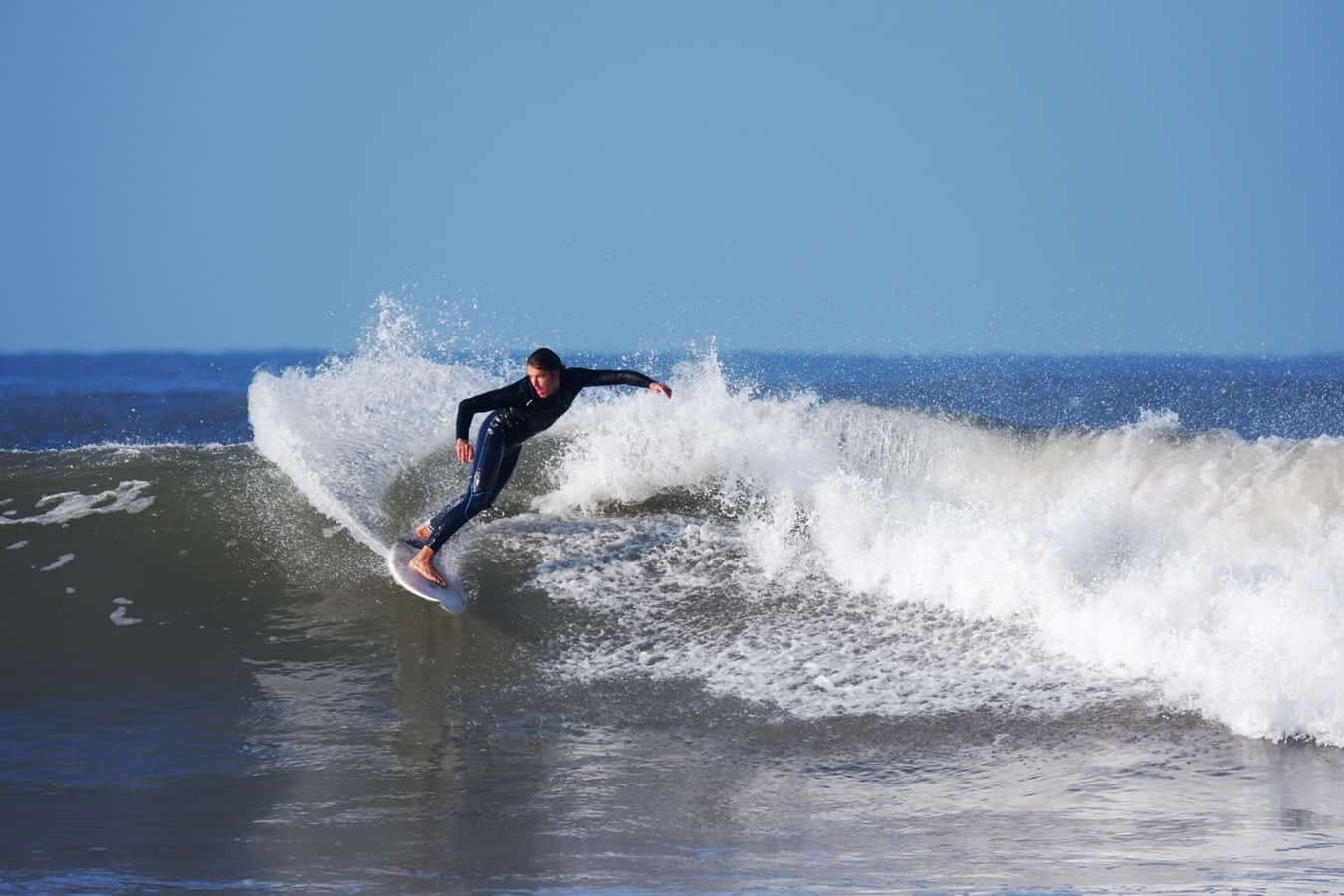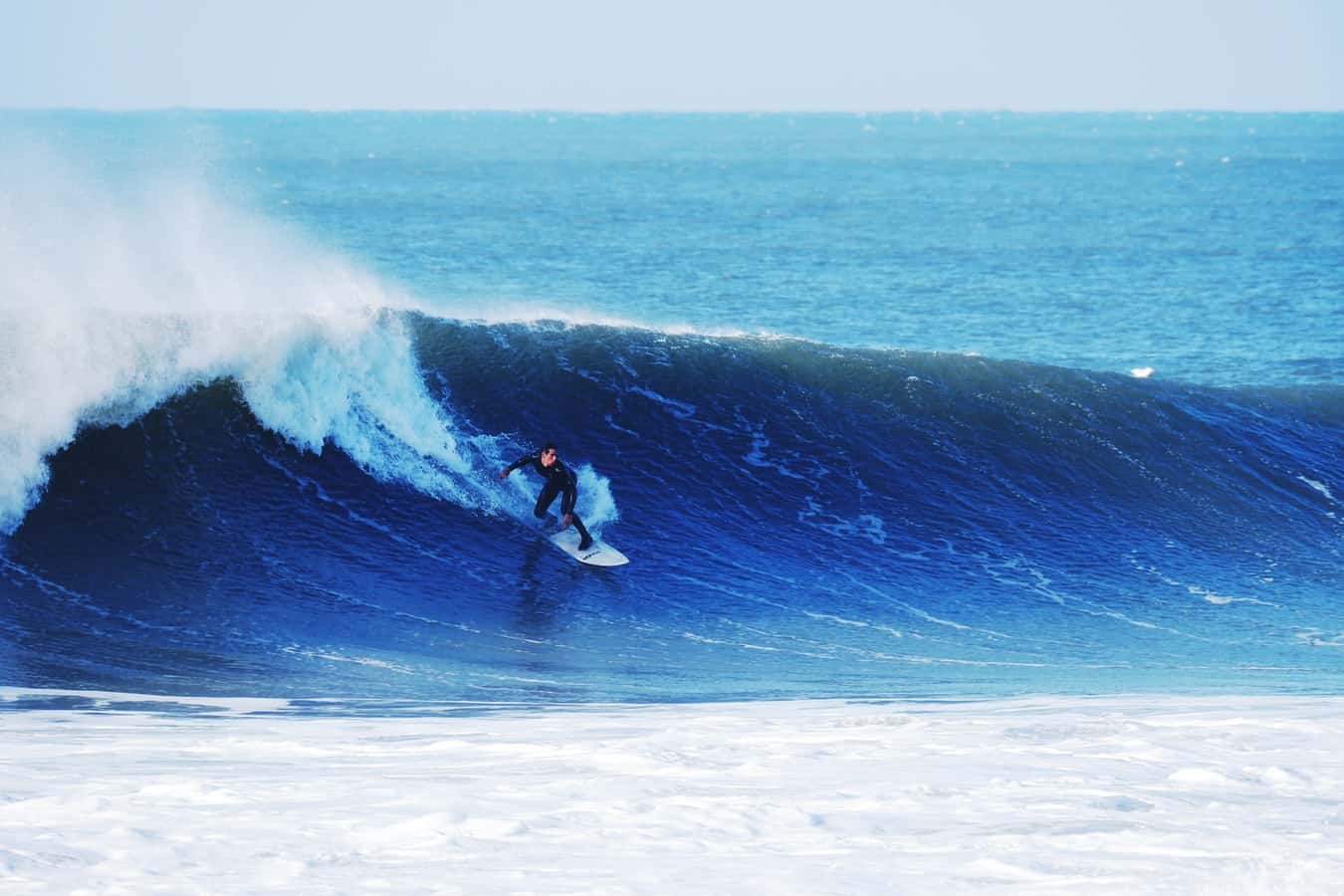There are days out in the water when waves are ripping, and there seem to be dozens to ride. There are also days when the waves are mellow, mushy, and smaller. You need to be able to move faster in these conditions. The waves are minutes apart. When you see them, you want to catch them.
You will ask, How can I speed up my surfing and surf faster? Generate speed on the top third of the wave. I pump the board, then trim to the shape of the wave.
Make your turns high on the wave and carve through the wave, doing cutbacks. Always ride the rails instead of moving nose to tail.
No two waves are alike, but we can place them in categories, and adjust to each wave type accordingly.
What Is The Best Way To Stand On A Surfboard To Go Faster?
Keep a low stance on the surfboard. Crouch your head and shoulders lower so there will be less wind resistance against your body. You will gain speed when you reach the pocket zone, which is the top third of the wave, closest to the wave’s crest. You surfboard speeds up at the top.
You’ll need to pump on the board and bounce to get to near the wave crest faster. Pumping is when you surf up and down the face of the wave. You move smoothly and flow naturally with the wave. Pumping allows you to position your surfboard in the wave pocket.
When you bounce, you general extra forward motion. You pounce as an alternative to paddling. Bouncing works well when the waves are smaller, or on bigger waves in areas where it is flat.
The better you are at trimming, the faster you’ll get to the wave crest. Trimming is cutting through to the top of the wave at an angle. Good surfers see the best angle of approach and go in that direction, then cut back and trim in the opposite direction until they get to the top third of the wave.
How Do I Gain Speed By Carving and Trimming?
Carving and trimming are two basic ways to turn your surfboard heading up to the wave’s crest. Once you learn to trim properly, you’ll then be able to carve and pick up even more speed.
Trimming is when you move your body weight to a particular area of your surfboard. When you trim along the face of the wave, you move your weight to an area of the board. Depending on where you put most of your weight, the surfboard, and your movement on it will be different.
To speed up, lean the torso of your body forward, your trunk moving past your front knee and your foot. Your body is like a car throttle: as you lean more and more forward, your speed increases. Note that if you apply too much pressure, the nose of the surfboard dips into the water, then slowing you down.
To slow down, press down on your back foot. Leaning your body in its direction. This will slow down the board.
One example of extreme trimming to slow your board down is by stalling the board. You do this when you see a wave approaching that you want to ride. You stall by placing as much weight as you can over the back of the board. This makes you stop until you can surf to the top of the wave.
An extreme way to trim and gain speed is to “hang ten,” which is when you put all ten toes over the nose of the surfboard, tipping it and making it accelerate very fast.
Making turns by trimming happens when you lean your weight over one side of the board or the other. If you lean to the left, you move in that direction, and vice versa. When you do this correctly, not only will you turn in the desired direction, but you’ll also be able to accelerate in the turn.
Lean your weight gently over one side of the board. Moving too fast will not let you go faster or turn as efficiently, and you might even fall off. The idea is to time yourself as perfectly as possible to match the wave’s activity, so you can get to the top at the exact right time.
If you angle the board too much, you’ll either trim off the back of the wave. This will put you too high on the face of the wave. With too little angle, you’ll find yourself surfing towards the shoreline of the beach.

What Is The Best Way To Trim My Surfboard?
As you are riding towards the beach in a straight line, slightly lean your body forward over your front foot. This will give you speed.
Next, apply pressure and rotate your torso to be in the direction you wish to trim the surfboard. Your head should remain level. Now, all at once, look where you want to go and raise your leading arm to make your surfboard turn.
It will take time to feel balanced on the board when you trim. If balancing becomes difficult, crouch low, bend your back leg, then grab the side of the board (the rail) that is on the opposite side of the direction you want to travel.
This is called the “pig dog” stance, and it will give you a strong base, or a good center of gravity, so you can hold your line as you travel across the wave.
What Is The Best Way To Do Carving Turns On My Surfboard?
Turning by carving through a wave allows you to change your direction quickly and helps you set up for bottom turning as well.
Your goal is to perform carving turns in the right part of the wave so you can maneuver the fastest to get to the top.
As you travel along the wave’s face, position to the top third of the wave. Lean your upper body over your back foot. At the same time, drop your weight into your hips and put your body into a crouched, compressed shape that’s closer to the board.
Angle your body weight towards the side of the board that’s in the direction you want to travel towards. As you make the turn, make sure you have plenty of speed, and that most of your weight is displaced near the fins of the surfboard.
Stay compressed and make your turn using your leading arm while simultaneously rotating your torso, and head forward. Steer into the direction you want to go.
Now moving in the right direction, move your weight onto your front foot once again. Begin extending your body out again into your normal surf stance (right foot above center, back foot behind, and near the rails).
How Do I Do A Bottom Turn?
Bottom turns may just be the most important maneuver in surfing. Bottom turns set you up for your next move and are critical for allowing you to get to the top of the wave fastest.
As you ride down the wave’s face, look in front of you and ahead. Find a place on the wave that will be the most effective for making a turn.
Once you find it, start applying pressure on your front to start leaning all your weight in the direction you want to take the surfboard.
Feeling the rail of the surfboard making contact with the wave, apply a good amount of pressure to your back foot. Now use your leading arm to put your body at an angle. And rotate your upper body towards your traveling direction. When you reach the place at the bottom of the wave you spotted earlier, start extending your body out of the turn. The closer you lean your chest and upper body to the wave, the sharper angle you’ll rise up on the wave.
A bottom turn should rocket you up to the top third of the wave. You should move like a slingshot.
Related Questions
Is Paddling Faster Than Trimming?
If you take a look at the pros surf, you’ll see that they paddle very little. This is because they know how to trim and cut back. They know the actions that the wave they’re going to ride will take beforehand, from years of experience.
Trimming and carving allow you to ride up to the power core of the wave near the top, rather than paddling and riding up the wave.
What Is The Fastest Surfboard?
The fastest surfboards are shortboards. Lighter and smaller than longboards, you can make it move quickly. The more expert you get at trimming, the lighter the surfboard you can use. Surfboards that are lighter and with less volume tend to move faster, as a general rule.
What Surfboard Should A Beginner Use To Trim?
A beginner can start with a foam surfboard (foamie), then move up to a mini mal (funboard). These boards are sized in between a shortboard and a longboard). If you want, you can try a shortboard before trying out a mini mal.

